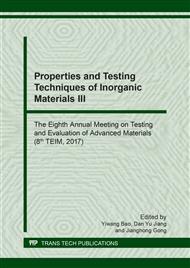p.3
p.8
p.13
p.19
p.24
p.31
p.36
p.41
Study of Tensile Bond Strength for Structural Silicone Sealants after Artificial Accelerated Aging
Abstract:
Tensile bond strength is one of the most significant properties for structural silicone sealants used in the glass curtain walls. During the service process, aging of the silicone sealants shall be involved in comprehensive actions of environment factors, e.g. temperature, humidity, and ultraviolet light etc. In this study, artificial accelerated aging test was conducted to make clear the development of tensile bond strength, Shore hardness and elongation. The test results show that: (i) the specimens under damp-heat test have more degeneration than specimens under humidity-freeze test; (ii) the environment of high temperature and high humidity leads to the change of tensile bond, Shore hardness, elongation, and results in interfacial failure of samples.
Info:
Periodical:
Pages:
13-18
Citation:
Online since:
April 2018
Authors:
Price:
Сopyright:
© 2018 Trans Tech Publications Ltd. All Rights Reserved
Share:
Citation:


